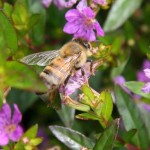Don’t use wasp spray as a substitute for pepper spray in a defensive situation By: Lynette Spicer, News Coordinator, Iowa State University & eXtension
Gun violence this fall at schools and colleges across the nation helps keep a contemporary legend alive. One version of the legend tells of a church receptionist working in a high risk area who kept a can of wasp spray on her desk for self defense. The legend, usually spread by email, suggests wasp spray draws less attention than a can of pepper spray and is effective against violence.

Poison control records document an amazing number of people who have accidentally sprayed themselves or innocent bystanders when using aerosol cans
“These emails may have initially begun as a hoax or simply a bad idea shared among an increasing number of people,” said Catherine Daniels, Pesticide Coordinator at Washington State Pest Management Resource Service.
“Unlike urban legends, which by and large don’t result in bodily harm, just odd behavior in people trying to avoid whatever danger the legend promotes, the advice in this email—if followed– can result in significant harm,” she said.
Janet Hurley, an Extension Specialist with the School Integrated Pest Management (IPM) program through Texas A&M AgriLife Extension Service, got many questions from school districts at the beginning of this school year. Hurley provided one example: “A school district in north Texas was inspecting its campuses at the beginning of the school year. The IPM Coordinators kept noticing cans of wasp killer in the offices of the school secretaries. Since the school follows IPM and has a policy about only licensed applicators making pesticide applications, the coordinators began to ask questions. Apparently, the secretaries had heard from a law enforcement person who said a can of wasp killer could injure an attacker at 10 feet and therefore would be a way to keep an intruder from school.”
Pesticide experts from Extension services at land-grant universities emphasize the public should use pepper sprays and pesticides only for their intended uses, and ask the public to help debunk urban legends about using wasp spray for defense. They also advise individuals to check with local law enforcement departments for specific laws about the possession and use of pepper spray products.
Why wasp spray should not be used for defense
1. There’s no research to suggest wasp spray would stop an attacker.
2. Using a pesticide in a manner other than according to labeled directions is a violation of federal law (the Federal Insecticide, Fungicide, and Rodenticide Act).
3. It is illegal (finable offense) for anyone to recommend a use other than the labeled use.
4. Personal liability is likely to be significant for a person who deliberately sprays another person with a pesticide.
5. Pesticides such as wasp spray have not been tested on humans. Direct human toxicity data comes from records of accidental exposures and suicide attempts.
6. Poison control records document an amazing number of people who have accidentally sprayed themselves or innocent bystanders when using aerosol cans. An emergency situation may exacerbate that reaction.
Pepper sprays
Capsaicin, the active heat ingredient from cayenne peppers, is used in the temporarily debilitating pepper spray weapons for personal protection. Canisters of pepper spray (also known as OC spray or oleoresin capsicum) dispense a solution containing capsaicin, an inflammatory agent which affects the eyes, respiratory system, skin and muscle coordination.
Wasp sprays
The active ingredients in most wasp sprays contain pyrethrins or pyrethroids. They are derived from a species of the chrysanthemum plant and affect the nervous system.
More information
- Insect sprays, http://www.epa.gov/kidshometour/products/ispray2.htm
- The University of California Berkeley Police Department, in its campus safety guidelines, lists the physical effects of pepper spray: http://police.berkeley.edu/documents/campus-safety/maceandpepper.pdf
Snopes.com tracks urban legends, http://www.snopes.com/crime/prevent/waspspray.asp
Sources: Catherine Daniels, PhD, Washington State University, cdaniels@wsu.edu; Janet Hurley, MPA, Texas A&M AgriLife Extension Service, ja-hurley@tamu.edu; Kaci Buhl, MS, Oregon State University, buhlk@ace.orst.edu
Controversy swirls around pesticides
By: Michael Merchant, PhD, BCE, Texas A&M AgriLife Extension Service, Dallas, TX
What could present a more peaceful, bucolic image than the scene of beekeepers tending their hives? Yet there is little peaceful about the scientific and political battle swirling about beekeepers and honeybees at the moment. At stake is nothing less than a group of insecticides that are growing in importance to the pest control industry in Texas.
In 2006 the domestic bee industry in the U.S. and in other countries around the world was hit hard with puzzling bee and colony losses, since referred to by researchers as Colony Collapse Disorder (CCD). Now many voices are blaming an important group of insecticides known as neonicotinoids. These same neonicotinoids include insecticides being found increasingly useful in control of bed bugs and ants, among other pests battled by PMPs.
The smoking gun against neonicotinoids came in the form of studies reported last year that show that one of the sub-lethal effects of low exposure neonicotinoids include loss of the bees’ sophisticated ability to find their way back home. This loss of homing ability would account for one of the more distinctive symptoms of CCD, namely colonies that slowly decline with no signs of dead bees around the hive. Other forms of colony decline typically include dead bees around the colony entrance.
In a typical year beekeepers expect to lose 10-15% of their colonies to disease and various stresses. Since CCD arrived, colony losses have averaged 30% each winter, a significant increase.
A recent panel convened by the USDA and EPA concluded that CCD is the result of multiple causes including parasites, poor nutrition, diseases, and overworked bees. However, despite protests from farmers and the warnings of many scientists that the jury is still out on causes of CCD, environmentalists this spring successfully lobbied for a temporary ban on agricultural uses of neonicotinoids in Europe.
To make matters worse, on June 19th of this year a pest control company in Wilsonville, Oregon sprayed several trees with the neonicotinoid insecticide dinotefuran. The sprays were applied to control an aphid infestation that was causing honeydew deposits on cars in a Target parking lot. The trees were in full bloom and, in direct violation of the label, they were sprayed during the day when bumble bee activity was at its peak. The resulting deaths of 50,000 bumble bees made national headlines and raised cries for a European-style ban of the use of neonicotinoids here in the U.S.
While there is no doubt that neonicotinoids are toxic to bees at high enough doses, scientists are still divided on the question of whether bees that forage on properly treated plants are exposed to high enough levels of toxicant to suffer from flight disorientation, and whether there is even a correlation between CCD and neonicotinoid use. Indeed, in some parts of the world where neonicotinoids are extensively used, such as Australia, CCD is not reported to be a problem.
If the scientists who study bees are divided on the cause of bee risks from pesticides, it’s likely that the answer to this question will be complex. But here are some points that might be useful as you consider how and whether to keep neonicotinoids in your company’s insecticide tool box, and how to respond to customer questions about these products.
- Both the USDA and EPA recently issued a report summarizing positions that CCD is a result of multiple factors, not just pesticides.
- All labels are approved on the basis that when used according to label directions the pesticide must not pose unreasonable adverse to humans or the environment, including honeybees. The EPA has recently reviewed registrations for some of these insecticides and stands by its risk/benefit assessment that these products can be used safely if the label is followed.
- While research is suggestive of a potential risk to bees from agricultural uses of neonicotinoids, the case is far from proven. And so far, to my knowledge, no credible sources have suggested that urban residential uses of neonicotinoids pose any unusual risk to bee colonies in urban areas.
- The greatest potential risk to bees from neonicotinoids appears to be in agricultural settings, where bee colonies are exposed to large acreages of treated plants. The diversity of plants and the relatively low use of pesticides in urban settings argues for lower potential risks in residential and commercial landscapes.
- Despite their toxicity to bees, neonicotinoid insecticides are relatively low in toxicity to people and mammals. This is due to unique nerve junction differences between insects and mammals. Just because an insecticide is toxic to bees doesn’t mean that it has broad ecological toxicity.
The Oregon experience should serve as a warning to exercise caution when spraying neonicotinoids directly on outdoor plants. They should not be sprayed on either weeds or ornamental plants when such plants are in bloom.
Remember to read all insecticide labels carefully. The label will tell you how to protect honeybees and other pollinators. But that same label is only useful if it is read and followed. Good product stewardship is the surest way to preserve neonicotinoids for use in the future.
What are Neonicotinoids?
Neonicotinoid insecticides are a relatively new class of systemic insecticides that have grown to make up approximately 20% of the global pesticide market. The first neonicotinoid to be introduced to the pest control market in the U.S. was imidacloprid, used for termite control (Premise®), landscape and lawn insect control (Merit®), and even bed bug (Temprid®) and flea control (Advantage®). Imidacloprid, remains at the center of the CCD controversy because of its widespread use in agriculture and in the ornamental landscape market. Other neonicotinoids currently in use by the pest control industry include dinotefuran (Safari®, Alpine®), thiamethoxam (in Optigard® and Tandem®) and acetamiprid (in Transport® and Temprid®). If you are not sure whether a product you may be using contains a neonicotinoid, check the active ingredients list on the front panel of the insecticide container. Because neonicotinoids are systemic, and can be taken up into plant tissues, they can be injected into the soil for control of many sucking pests, eliminating the need to spray.


 .
.